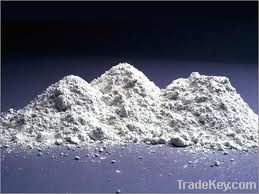详情
Portland cement (often referred to as OPC, from Ordinary Portland
Cement) is the most common type of cement in general use around
the world because it is a basic ingredient of concrete, mortar,
stucco and most non-specialty grout. It is a fine powder produced
by grinding Portland cement clinker (more than *0%), a limited
amount of calcium sulfate (which controls the set time) and up to
5% minor constituents as allowed by various standards such as the
European Standard EN****1:Portland cement clinker is a hydraulic
material which shall consist of at least two-thirds by mass of
calcium silicates (3 CaO·SiO2 and 2 CaO·SiO2), the remainder
consisting of aluminium- and iron-containing clinker phases and
other compounds. The ratio of CaO to SiO2 shall not be less than
2.0. The magnesium oxide content (MgO) shall not exceed 5.0% by
mass.ASTM C **0 defines portland cement as "hydraulic cement
(cement that not only hardens by reacting with water but also
forms a water-resistant product) produced by pulverizing clinkers
consisting essentially of hydraulic calcium silicates, usually
containing one or more of the forms of calcium sulfate as an
inter ground addition." Clinkers are nodules (diameters, 0.**1.0
inch [5–*5 mm]) of a sintered material that is produced when a
raw mixture of predetermined composition is heated to high
temperature. The low cost and widespread availability of the
limestone, shales, and other naturally occurring materials make
portland cement one of the lowest-cost materials widely used over
the last century throughout the world. Concrete becomes one of
the most versatile construction materials available in the world.
Portland cement clinker is made by heating, in a kiln, a
homogeneous mixture of raw materials to a sintering temperature,
which is about ***0 °C for modern cements. The aluminium oxide
and iron oxide are present as a flux and contribute little to the
strength. For special cements, such as Low Heat (LH) and Sulfate
Resistant (SR) types, it is necessary to limit the amount of
tricalcium aluminate (3 CaO·Al2O3) formed. The major raw material
for the clinker-making is usually limestone (CaCO3) mixed with a
second material containing clay as source of alumino-silicate.
Normally, an impure limestone which contains clay or SiO2 is
used. The CaCO3 content of these limestones can be as low as *0%.
Second raw materials (materials in the rawmix other than
limestone) depend on the purity of the limestone. Some of the
second raw materials used are: clay, shale, sand, iron ore,
bauxite, fly ash and slag. When a cement kiln is fired by coal,
the ash of the coal acts as a secondary raw material.
| 国家: |
India |
| 型号: |
BS EN 197
|
| 离岸价格: |
(面議)
获取最新报价
|
| 位置: |
India |
| 最小订单价格: |
- |
| 最小订单: |
500 Metric Ton |
| 包装细节: |
50 Kg PP Bag |
| 交货时间: |
7-10 days after receipt of Payment |
| 供应能力: |
5000 Metric Ton per Month |
| 付款方式: |
T/T, L/C |
| 產品組 : |
Construction Material
|

